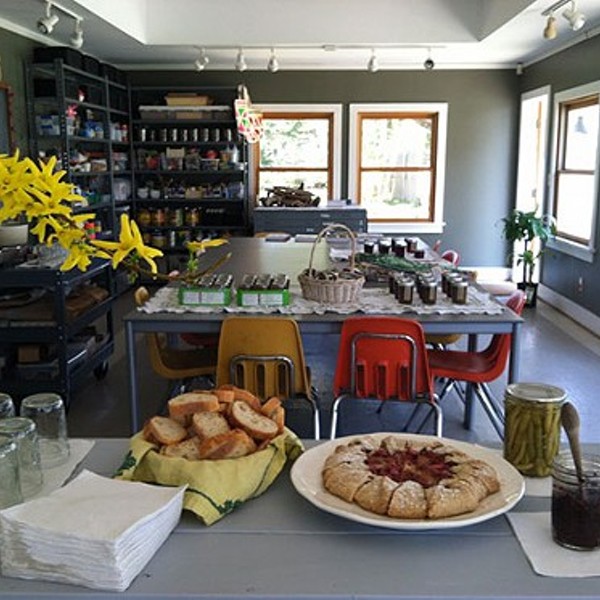Granted, Tolstoy and Flaubert were more concerned with character and plot development than in teaching their readers to cook. It’s also fair to assume that they had no personal experience of the preserving process, and so couldn’t appreciate its rewards. But what of our women writers? George Sand is said by her biographer to have adored making jam, but I’m not aware that this was reflected in any of her novels. And it is interesting that even Louisa May Alcott in Little Women takes a break from championing domestic pursuits to serve up a scene of fruit preserving as a comical disaster.
In an episode worthy of “I Love Lucy,” the newly-wed Meg, striving to become the perfect little housewife, decides to make jelly from her homegrown currants. After a day of exhausting labor, the fruit has refused to jell, and Meg ends up sobbing in the kitchen, amidst multiple batches of fruit in various stages of boiling, burning, and dripping. Then her husband, outdoing even Ricky Ricardo, comes home with an unexpected guest in tow, chuckles at the mess and her tears, and asks that she serve them dinner! Not a pretty picture.
So if you want to make jam or jelly you’d be better off seeking out a good cookbook than a novel. And please, don’t let these grim fictional portrayals discourage you from engaging in one of summertime’s most gratifying experiences. Just as wood is said to warm you twice—first, when you cut it, the second time, when you burn it—so can jam and jelly delight the senses not only when you eat them, but when you make them. The aroma of the cooking fruit, the jewel-like colors, the magical moment of transformation—the “jelling”—and the gratification of seeing the fruits of your labors tucked away—these rival the considerable pleasure you will have from the actual eating of your homemade preserves.
You can even add even another layer of pleasure by picking your own fruit. As in those old recipes that start “First, catch the chicken,” you have to first pick your fruit. And you owe it to yourself to do it yourself, in the many fantastic farms and orchards of the Hudson Valley. Not only will you get the best and freshest fruit, you will have a wonderful time. Lodged forever in my memory is a magical day I spent with friends picking sour cherries in a Columbia County orchard. It was a transporting experience to plunge into the trees, reaching for the neon-red fruit glowing against a bright blue sky, surrounded by spectacular views of the mountains and valleys.
Before you tackle a specific recipe, here are some helpful general hints.
Jam and jelly
Jams and jellies are both made from fruit and sugar. Jam is made with the flesh of the fruit, chopped or crushed into various degrees of chunkiness, so that in the final product bits of fruit are dispersed throughout a soft jell. Jelly is made just with the juice of the fruit, with the fruit pulp strained out, so that the final product is a clear jell, usually somewhat stiffer than jam. (From whence come the lyrics of that great jazz and blues favorite, “It Must Be Jelly [Cause Jam Don’t Shake Like That],” which describe the effect of certain movements on certain anatomical parts.)
Pectin and jelling
There is a kernel of truth to the portrayal of fruit preserving as a technically difficult process. A lot of it has to do with what the poet Elma Mitchell called the “terrible chemistry of … [the] kitchen,” specifically, the vagaries of pectin, the substances that turns the sugared juice into a jell. Pectin is a kind of carbohydrate found in all fruits and vegetables, where it helps to maintain the structure of the cell walls. When fruit is cooked, the pectin is liberated from the cells, causing the fruit to soften, and the juices to emerge. To get the juices and sugar to jell, the pectin molecules need to reassemble in the liquid. The reassembling process is helped along by heating, stirring, and by the chemical effects of sugar and acid. Lots of things can prevent proper jelling, including overcooking (what probably happened to Meg in Little Women) or insufficient amounts of sugar or acid.
One way to deal with this is to add commercial pectins, extracted from fruit, which come in both powdered and liquid forms. When I first started making jam, the only such available products had additives that I wanted to avoid, and the directions called for much larger proportions of sugar than traditional recipes without added pectins. So I did without the added pectin, relying on the pectin naturally in the fruit, and haven’t found any reason to change my ways. I’m willing to risk a less-than-fully-jelled product, since I actually prefer a runny, relaxed jam to the stiffer kind. And if it doesn’t jell at all, I call it syrup or sauce and get on with it.













